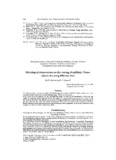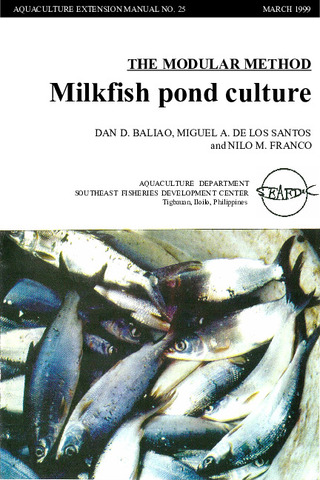Histological observations on the rearing of milkfish, Chanos chanos, fry using different diets
- Global styles
- MLA
- Vancouver
- Elsevier - Harvard
- APA
- Help
Share
Abstract
Six different diets, commonly used in the Philippines for rearing milkfish, Chanos chanos, try, were tested by means of growth, survival and histology. These diets included:
a) live food (Artemia nauplii); b) two different dry feeds; c) natural feed supplements (rice bran, egg yolk); d) a mixture of live and dry feeds. The mixed diet was found to give the best results, closely followed by live food. The dietary value of one of both artificial feeds improved with increasing age of the fish, whereas the other was clearly inadequate. The same was true for the natural compounds. Results obtained from statistical and histological analyses were congruent; the latter provided additional insights not obtained with statistic data alone.
Suggested Citation
Segner, H., & Juario, J. V. (1986). Histological observations on the rearing of milkfish, Chanos chanos, fry using different diets. Journal of Applied Ichthyology , 2(4), 162-172. https://doi.org/10.1111/j.1439-0426.1986.tb00658.x
Type
ArticleISSN
0175-8659Collections
- Journal Articles [1258]
Related items
Showing items related by title, author, creator and subject.
-
Series: Aquaculture extension manual; No. 25
The modular method: Milkfish pond culture
Baliao, Dan D.; de los Santos, Miguel A.; Franco, Nilo M. (Aquaculture Department, Southeast Asian Fisheries Development Center, 1999)The modular method of milkfish culture (Chanos chanos) described in the manual is an improvement over the traditional extensive method. The manual is intended for the use of fish farmers and aquaculturists, extensionists, ... -
Evaluation of organic and inorganic fertilizers in brackishwater milkfish ponds
Bombeo-Tuburan, Isidra; Agbayani, Renato F.; Subosa, Precilla F. (Elsevier, 1989)The study was conducted in twelve 144-m2 ponds to evaluate the effect of different organic and inorganic fertilizers on the growth, survival, gross production, and profitability of marketable milkfish. The ... -
Milkfish breeding and hatchery technology at SEAFDEC/AQD
Unknown author (Aquaculture Department, Southeast Asian Fisheries Development Center, 1999)Describes the techniques already adopted by the private sector: broodstock management, broodstock diet, commercial fry production, live transport, and larval diet. A list of AQD research publications on milkfish is included.






